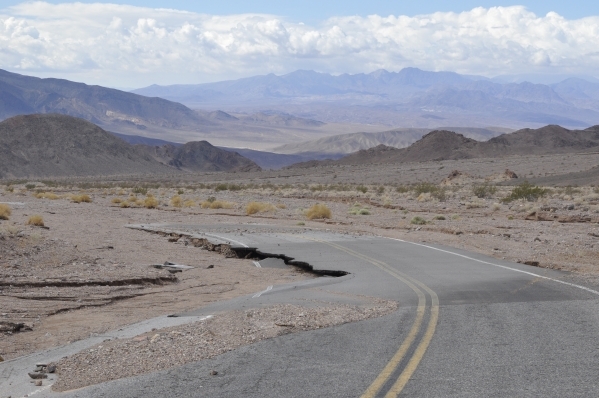Death Valley recovering from flooding

Death Valley National Park remains an inviting cool-season destination despite record rain and flash flooding in October that closed some roads and attractions.
About a third of the park’s roads were affected by the flooding, but most roads have been cleared and are open. Closed routes include state Route 267 to Scotty’s Castle and nearby Ubehebe Crater and Mesquite Campground and state Route 178 south of Badwater from Ashford Mill toward Shoshone through Jubilee Pass.
Park facilities at Furnace Creek and Stovepipe Wells are fully operational. The scenic Artist’s Drive side road is closed and restrictions may be in place through Twenty Mule Team Canyon, but other routes to Dante’s View, Mustard Canyon and Titus Canyon are open. Four-wheel-drive, high-clearance vehicles are best used through Titus Canyon. After debris cleanup, the West Side Road is again open.
The closest national park for Southern Nevadans, Death Valley lies 150 miles from Las Vegas by the shortest route through Pahrump Valley on state Route 160 to Bell Vista Road, a shortcut to Death Valley Junction. From the junction, follow state Route 190 to park headquarters at Furnace Creek. With access to Death Valley from the north and south closed at this time, the only other route from Las Vegas to the park follows U.S. Highway 95 north to Beatty and then state Route 374 south through Daylight Pass into the park. This road was closed for a while during the flooding.
During the deluge that hit the park’s northern end Oct. 18, 3½ inches of rain fell in five hours, just half an inch less than the area’s average yearly rainfall. The same storm brought more than an inch of rain to Furnace Creek. Several storms followed the first on Oct. 18, making October 2015 the wettest month on record in Death Valley. Although very damaging and inconvenient for stranded motorists and evacuated campers, the October storms were not as dangerous as the rain and flooding in August 2004 that killed two people and closed Death Valley for 10 days.
It will probably be many months before visitors will be able to enjoy the various tours usually offered at Scotty’s Castle. The popular tours of the opulent second home built by a wealthy couple in the 1920s included the multistory mansion, its underground utility tunnels and the nearby cabin built for Death Valley Scotty by his rich friends from Chicago. The tours drew about 120,000 visitors and generated more than $500,000 annually.
Flood damage was extensive to the highway, grounds, utilities, visitor center and bookstore and almost every building in the Scotty’s Castle historic complex. Fortunately, the grand house itself was spared except for some damage from leaks and flooding beneath the structure and in the courtyard. Even the sturdy bridge was affected, moved a foot on its foundation, though still structurally sound.
A team of more than 100 people from the National Park Service and associated agencies has been assessing damage, planning recovery and starting the labor of removing mud and debris, restoring water and power and safely storing museum-quality furnishings, decor, collections and exhibits. A one-lane road provides access to the site in remote Grapevine Canyon. Estimates for the repair and salvage work run into tens of millions of dollars.
Because of that heavy rainfall in October and a few lighter storms since then, Death Valley visitors in 2016 are likely to get a delightful bonus. Death Valley may produce one of its rare spectacular wildflower shows this spring, which in the area starts next month and peaks in late March or early April. After the requisite inch of rain in November and December, all it takes to keep the seeds sprouting and the plants growing is a decent shower once a month, some sunshine and not too much wind.
Because conditions for a good wildflower year are so specific, an outstanding season occurs only about once every 10 years.
— Margo Bartlett Pesek’s Trip of the Week column appears on Sundays.












